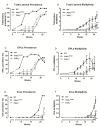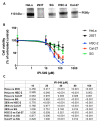Chemical Oral Cancerogenesis Is Impaired in PI3Kγ Knockout and Kinase-Dead Mice
- PMID: 34439365
- PMCID: PMC8391366
- DOI: 10.3390/cancers13164211
Chemical Oral Cancerogenesis Is Impaired in PI3Kγ Knockout and Kinase-Dead Mice
Abstract
We investigated the role of PI3Kγ in oral carcinogenesis by using a murine model of oral squamous carcinoma generated by exposure to 4-nitroquinoline 1-oxide (4NQO) and the continuous human cancer cell line HSC-2 and Cal-27. PI3Kγ knockout (not expressing PI3Kγ), PI3Kγ kinase-dead (carrying a mutation in the PI3Kγ gene causing loss of kinase activity) and wild-type (WT) C57Bl/6 mice were administered 4NQO via drinking water to induce oral carcinomas. At sacrifice, lesions were histologically examined and stained for prognostic tumoral markers (EGFR, Neu, cKit, Ki67) and inflammatory infiltrate (CD3, CD4, CD8, CD19 and CD68). Prevalence and incidence of preneoplastic and exophytic lesions were significantly and similarly delayed in both transgenic mice versus the control. The expression of prognostic markers, as well as CD19+ and CD68+ cells, was higher in WT, while T lymphocytes were more abundant in tongues isolated from transgenic mice. HSC-2 and Cal-27 cells were cultured in the presence of the specific PI3Kγ-inhibitor (IPI-549) which significantly impaired cell vitality in a dose-dependent manner, as shown by the MTT test. Here, we highlighted two different mechanisms, namely the modulation of the tumor-infiltrating cells and the direct inhibition of cancer-cell proliferation, which might impair oral cancerogenesis in the absence/inhibition of PI3Kγ.
Keywords: 4NQO; PI3Kγ; chemical carcinogenesis; oral squamous cell carcinoma; transgenic mice.
Conflict of interest statement
The authors declare no conflict of interest.
Figures




References
-
- Fumagalli L., Campa C.C., Germena G., Lowell C.A., Hirsch E., Berton G. Class I phosphoinositide-3-kinases and SRC kinases play a nonredundant role in regulation of adhesion-independent and -dependent neutrophil reactive oxygen species generation. J. Immunol. 2013;190:3648. doi: 10.4049/jimmunol.1201951. - DOI - PMC - PubMed
-
- Okkenhaug K., Graupera M., Vanhaesebroeck B. Targeting PI3K in Cancer: Impact on Tumor Cells, Their Protective Stroma, Angiogenesis, and Immunotherapy. Cancer Discov. 2016;6:1090. doi: 10.1158/2159-8290.CD-16-0716. - DOI - PMC - PubMed
Grants and funding
LinkOut - more resources
Full Text Sources
Research Materials
Miscellaneous

